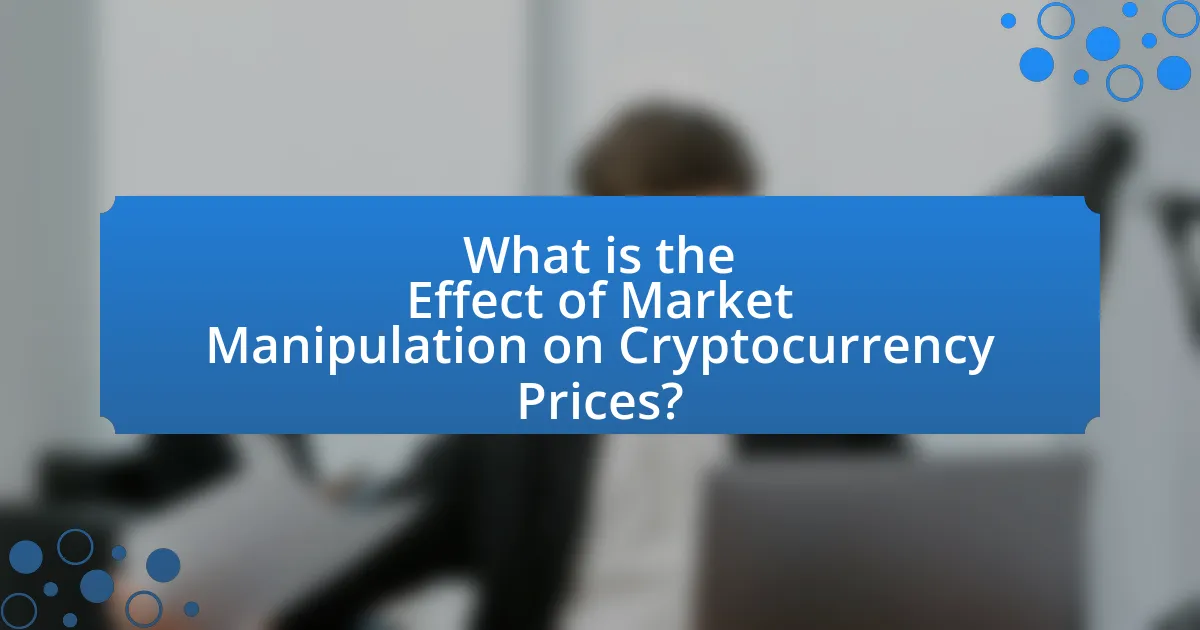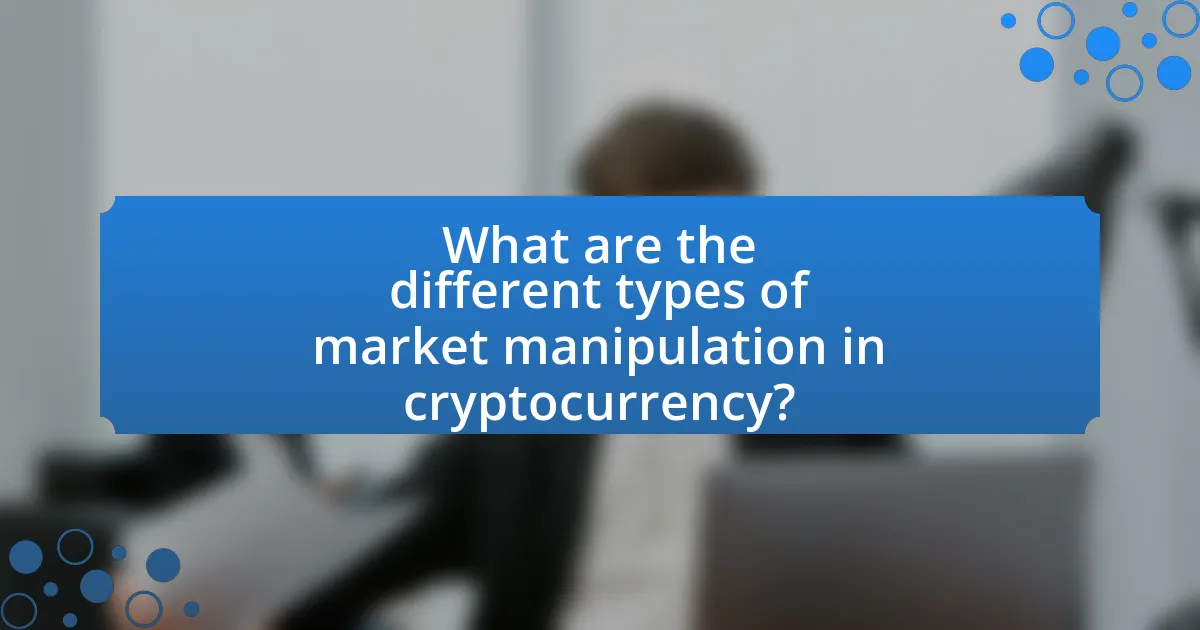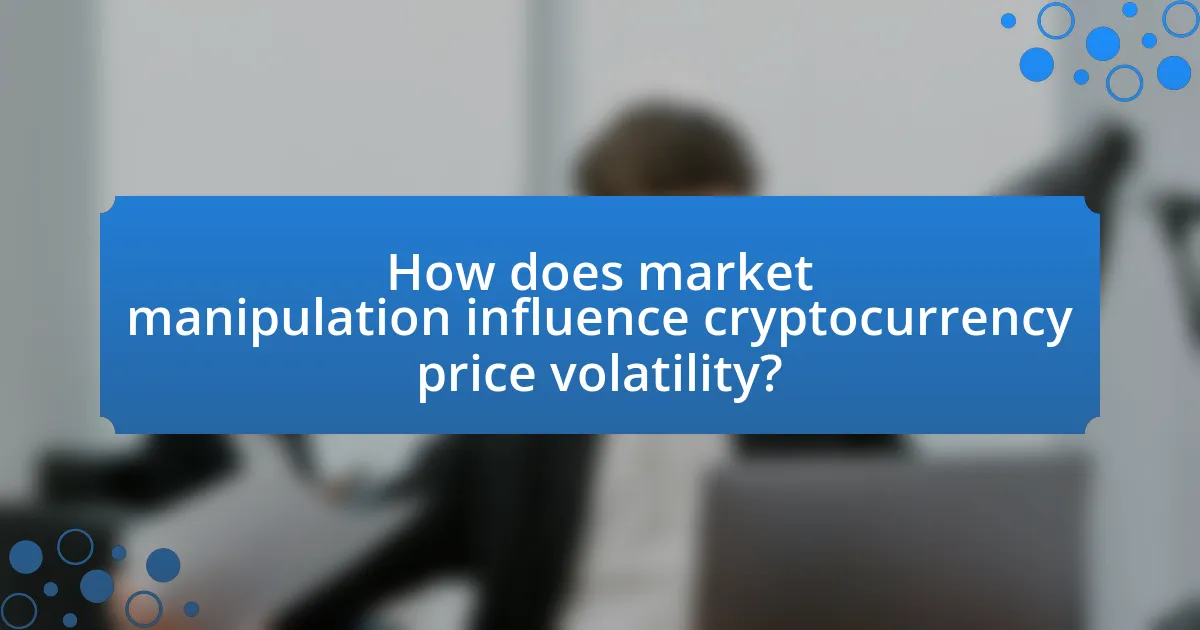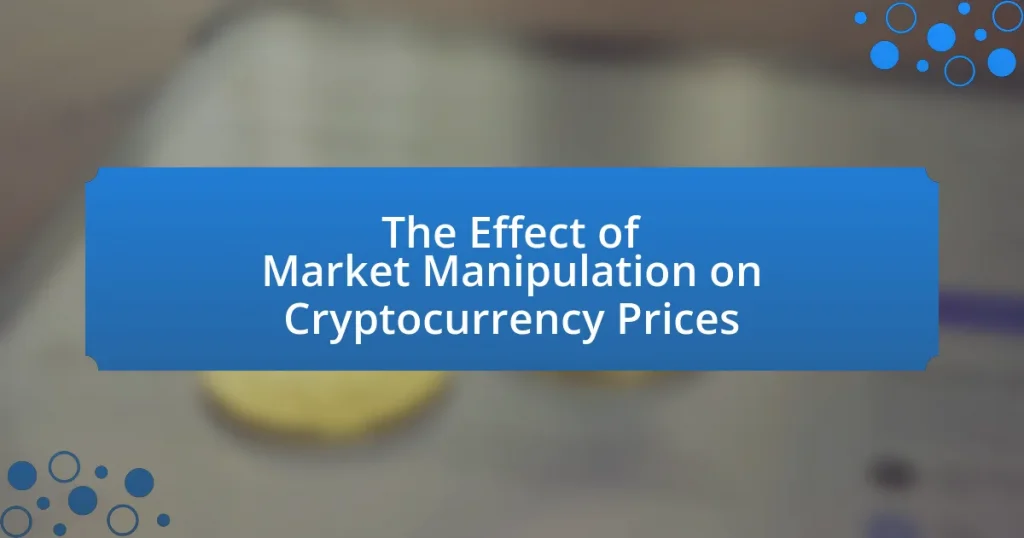Market manipulation significantly impacts cryptocurrency prices, leading to artificial inflation or deflation through tactics such as pump-and-dump schemes, spoofing, and wash trading. These manipulative practices distort market integrity, increase volatility, and create challenges for genuine investors in making informed decisions. Understanding the mechanisms of market manipulation is crucial for investors to navigate risks, protect their investments, and recognize warning signs of deceptive practices. The article explores the various tactics employed in market manipulation, their effects on investor behavior, and strategies for mitigating risks associated with these practices.

What is the Effect of Market Manipulation on Cryptocurrency Prices?
Market manipulation significantly distorts cryptocurrency prices, often leading to artificial inflation or deflation. This occurs through tactics such as pump-and-dump schemes, where manipulators artificially inflate prices to sell at a profit, causing subsequent price crashes. For instance, a study by the University of Technology Sydney found that 80% of cryptocurrency exchanges exhibit signs of manipulation, impacting market integrity and investor trust. Such practices can lead to increased volatility, making it difficult for genuine investors to make informed decisions.
How does market manipulation occur in the cryptocurrency market?
Market manipulation in the cryptocurrency market occurs through tactics such as pump-and-dump schemes, spoofing, and wash trading. In pump-and-dump schemes, manipulators artificially inflate the price of a cryptocurrency by spreading false information or hype, leading unsuspecting investors to buy in, after which the manipulators sell off their holdings at the inflated price, causing the price to crash. Spoofing involves placing large orders that are canceled before execution to create a false sense of demand or supply, misleading other traders. Wash trading is the practice of buying and selling the same asset to create misleading activity levels, giving the illusion of increased interest in a cryptocurrency. These practices exploit the relatively low liquidity and regulatory gaps in the cryptocurrency market, making it susceptible to manipulation.
What are the common tactics used for market manipulation?
Common tactics used for market manipulation include pump and dump schemes, spoofing, and wash trading. Pump and dump schemes involve artificially inflating the price of an asset through misleading information, followed by selling off the asset at the inflated price. Spoofing entails placing large orders that are canceled before execution to create a false sense of demand or supply, influencing other traders’ decisions. Wash trading involves buying and selling the same asset simultaneously to create misleading activity and volume, which can mislead investors about the asset’s true market interest. These tactics have been documented in various regulatory reports and studies, highlighting their prevalence in both traditional and cryptocurrency markets.
How do these tactics impact investor behavior?
Market manipulation tactics significantly influence investor behavior by creating artificial price movements that can lead to irrational decision-making. When investors perceive sudden price increases or decreases, they may react emotionally, either by buying into a rising market out of fear of missing out or selling in a panic during a downturn. Research indicates that such behaviors are often driven by psychological biases, such as herd mentality, where individuals follow the actions of others rather than making independent assessments. For instance, a study published in the Journal of Behavioral Finance found that manipulated price signals can lead to increased trading volume and volatility, as investors rush to capitalize on perceived opportunities or mitigate losses. This demonstrates that market manipulation not only distorts actual market conditions but also alters the fundamental decision-making processes of investors.
Why is understanding market manipulation important for cryptocurrency investors?
Understanding market manipulation is crucial for cryptocurrency investors because it directly impacts price volatility and investment decisions. Market manipulation can lead to artificial price movements, causing investors to make uninformed choices based on misleading signals. For instance, the 2017 Bitcoin price surge was partly attributed to coordinated pump-and-dump schemes, which misled many investors and resulted in significant financial losses. Recognizing these manipulative tactics enables investors to better navigate the market, protect their investments, and make more informed trading decisions.
What risks do investors face due to market manipulation?
Investors face significant risks due to market manipulation, including financial losses, distorted market perceptions, and increased volatility. Financial losses occur when manipulated prices lead investors to make poor trading decisions, often resulting in buying high and selling low. Distorted market perceptions arise from artificial price movements that mislead investors about the true value of assets, leading to misguided investment strategies. Increased volatility is a direct consequence of manipulation, as sudden price swings can trigger panic selling or buying, further destabilizing the market. Historical instances, such as the 2017 Bitcoin price surge driven by coordinated pump-and-dump schemes, illustrate how manipulation can lead to substantial financial repercussions for unsuspecting investors.
How can awareness of manipulation strategies protect investors?
Awareness of manipulation strategies can protect investors by enabling them to identify and avoid deceptive practices that can lead to financial losses. By understanding tactics such as pump-and-dump schemes, where prices are artificially inflated before being sold off, investors can make informed decisions and recognize warning signs. Research indicates that informed investors are less likely to fall victim to manipulation; for instance, a study published in the Journal of Financial Economics found that awareness of market manipulation significantly reduces the likelihood of investment losses. This knowledge empowers investors to conduct thorough due diligence and engage in risk management, ultimately safeguarding their investments against fraudulent activities.

What are the different types of market manipulation in cryptocurrency?
Market manipulation in cryptocurrency includes practices such as pump and dump schemes, wash trading, spoofing, and insider trading. Pump and dump schemes involve artificially inflating the price of a cryptocurrency through misleading information, followed by selling off at the peak price. Wash trading occurs when traders buy and sell the same asset to create misleading activity, giving the illusion of high demand. Spoofing involves placing large orders that are canceled before execution to manipulate prices. Insider trading refers to trading based on non-public information, which can unfairly influence market prices. These manipulative practices undermine market integrity and can lead to significant price volatility.
What is pump and dump, and how does it affect prices?
Pump and dump is a fraudulent scheme where the price of a cryptocurrency is artificially inflated through misleading or false statements, followed by a rapid sell-off by the perpetrators. This manipulation leads to a temporary spike in prices, attracting unsuspecting investors who buy in, only to see the price plummet once the manipulators sell their holdings. Historical instances, such as the 2017 Bitcoin pump and dump schemes, demonstrate that such actions can result in significant financial losses for investors and contribute to overall market volatility.
What are the signs of a pump and dump scheme?
The signs of a pump and dump scheme include sudden and unexplained price increases, heavy promotional activity, and a lack of fundamental value in the asset. In a pump and dump scheme, the price of a cryptocurrency is artificially inflated through misleading information and hype, often driven by social media or online forums. Once the price reaches a peak, the perpetrators sell their holdings, causing the price to plummet and leaving other investors with significant losses. Historical cases, such as the BitConnect collapse in 2018, illustrate how these schemes can lead to rapid price spikes followed by steep declines, highlighting the importance of recognizing these signs to avoid financial loss.
How can investors avoid falling victim to pump and dump schemes?
Investors can avoid falling victim to pump and dump schemes by conducting thorough research on any cryptocurrency before investing. This includes analyzing the project’s fundamentals, team background, and market trends. According to the U.S. Securities and Exchange Commission, pump and dump schemes often involve misleading promotions and sudden price spikes, which can be identified through unusual trading volume and social media hype. By remaining skeptical of investments that promise quick returns and verifying information from credible sources, investors can protect themselves from these manipulative tactics.
What role does wash trading play in cryptocurrency price manipulation?
Wash trading plays a significant role in cryptocurrency price manipulation by creating an illusion of increased trading volume and demand. This practice involves traders buying and selling the same asset simultaneously to artificially inflate its trading activity, which can mislead other investors into believing that the asset is more popular or valuable than it actually is. For instance, a study by the Blockchain Transparency Institute found that wash trading accounted for approximately 70% of the trading volume on certain exchanges, indicating a substantial impact on perceived market activity. This inflated volume can lead to price increases, as unsuspecting investors may enter the market based on the false signals generated by wash trading, ultimately distorting the true market dynamics.
How does wash trading create a false sense of market activity?
Wash trading creates a false sense of market activity by artificially inflating trading volumes through simultaneous buying and selling of the same asset. This practice misleads investors into believing there is genuine interest and liquidity in the market, which can drive up prices and attract more participants. For instance, a study by the University of Technology Sydney found that wash trading can account for up to 70% of reported trading volume on certain cryptocurrency exchanges, indicating that the perceived market activity is often not reflective of actual demand.
What are the regulatory implications of wash trading?
Wash trading is considered illegal market manipulation, leading to significant regulatory implications for individuals and firms involved. Regulatory bodies, such as the U.S. Securities and Exchange Commission (SEC) and the Commodity Futures Trading Commission (CFTC), impose penalties, including fines and trading bans, on entities engaging in wash trading to maintain market integrity. For instance, the SEC has taken enforcement actions against firms for wash trading practices, highlighting the legal risks and potential criminal charges associated with such activities. These regulations aim to protect investors and ensure fair market conditions, emphasizing the importance of compliance in the cryptocurrency market.

How does market manipulation influence cryptocurrency price volatility?
Market manipulation significantly increases cryptocurrency price volatility by creating artificial price movements that do not reflect true market demand. Techniques such as pump-and-dump schemes, where manipulators inflate the price of a cryptocurrency through misleading information and then sell off their holdings, lead to sharp price increases followed by rapid declines. For instance, a study by the University of Technology Sydney found that such manipulative practices can cause price fluctuations exceeding 20% within a single day. This volatility undermines market stability and can lead to substantial financial losses for unsuspecting investors.
What are the short-term effects of manipulation on cryptocurrency prices?
Short-term manipulation of cryptocurrency prices typically results in significant price volatility, often leading to rapid increases or decreases in value. This volatility can be driven by tactics such as pump-and-dump schemes, where prices are artificially inflated through misleading information, followed by a sudden sell-off that causes prices to plummet. For instance, a study by the University of Technology Sydney found that manipulated trades can lead to price distortions of up to 20% within a short time frame. Additionally, the presence of large trades can create a false sense of demand, further exacerbating price fluctuations. These effects highlight the susceptibility of cryptocurrency markets to manipulation, resulting in unpredictable trading environments for investors.
How do sudden price changes affect market sentiment?
Sudden price changes significantly impact market sentiment by triggering emotional responses among investors. When prices rise sharply, it often generates excitement and optimism, leading to increased buying activity, as seen during Bitcoin’s rapid price surge in late 2017, which fueled a bullish market sentiment. Conversely, abrupt price declines can instill fear and panic, prompting sell-offs, as evidenced by the market reactions during the 2018 cryptocurrency crash, where negative sentiment led to a substantial decrease in trading volumes and investor confidence. These emotional reactions are critical in shaping market dynamics, as they influence trading behaviors and overall market trends.
What are the implications for trading strategies during volatile periods?
During volatile periods, trading strategies must adapt to increased price fluctuations and uncertainty. Traders often implement risk management techniques, such as tighter stop-loss orders, to mitigate potential losses from sudden market movements. Historical data shows that during high volatility, such as the 2017 cryptocurrency market surge, prices can swing dramatically, leading to both opportunities and risks. Additionally, traders may shift to short-term strategies, capitalizing on rapid price changes, as seen in the 2020 Bitcoin price fluctuations, where day trading became prevalent. These adaptations are essential for navigating the challenges posed by market manipulation and ensuring effective trading outcomes.
What are the long-term consequences of market manipulation on cryptocurrency markets?
Market manipulation in cryptocurrency markets leads to long-term consequences such as decreased investor trust, increased volatility, and potential regulatory scrutiny. When manipulation occurs, it distorts the true value of assets, causing investors to make decisions based on artificial price movements rather than genuine market conditions. This can result in a loss of confidence among investors, as seen in cases like the Bitconnect collapse, where manipulated prices led to significant financial losses for many. Furthermore, persistent manipulation can attract regulatory attention, prompting governments to impose stricter regulations, which may stifle innovation and limit market participation. Historical data indicates that markets with a history of manipulation often experience prolonged periods of instability, further deterring legitimate investment.
How does manipulation affect market integrity and trust?
Market manipulation undermines market integrity and trust by creating artificial price movements that mislead investors. When traders engage in practices such as pump-and-dump schemes or wash trading, they distort the true value of assets, leading to a loss of confidence among market participants. According to a 2020 report by the Financial Conduct Authority, 20% of retail investors in cryptocurrency markets reported experiencing losses due to manipulation, highlighting the detrimental impact on trust. This erosion of trust can result in decreased participation in the market, ultimately harming its overall stability and functionality.
What impact does manipulation have on regulatory responses?
Manipulation significantly influences regulatory responses by prompting authorities to implement stricter oversight and enforcement measures. When market manipulation occurs, it undermines investor confidence and market integrity, leading regulators to react by enhancing regulations to protect investors and ensure fair trading practices. For instance, the U.S. Securities and Exchange Commission (SEC) has increased scrutiny on cryptocurrency exchanges following instances of price manipulation, such as pump-and-dump schemes, which have been documented in various reports. This heightened regulatory focus aims to mitigate risks associated with fraudulent activities and stabilize the market environment.
What strategies can investors use to mitigate the effects of market manipulation?
Investors can mitigate the effects of market manipulation by employing strategies such as diversifying their portfolios, conducting thorough research, and utilizing stop-loss orders. Diversification reduces risk by spreading investments across various assets, which can buffer against the impact of manipulated prices in any single cryptocurrency. Conducting thorough research helps investors identify potential red flags associated with market manipulation, such as unusual trading volumes or price movements that deviate significantly from historical trends. Utilizing stop-loss orders allows investors to set predetermined exit points, minimizing losses in the event of sudden price drops caused by manipulation. These strategies are supported by historical instances where diversified portfolios have outperformed concentrated investments during market volatility, demonstrating their effectiveness in protecting against manipulation.
How can investors conduct due diligence to identify potential manipulation?
Investors can conduct due diligence to identify potential manipulation by analyzing trading volume patterns, price movements, and market sentiment indicators. By examining unusual spikes in trading volume that do not correlate with news or events, investors can detect signs of potential manipulation. For instance, a significant increase in trading volume accompanied by a sharp price increase may indicate pump-and-dump schemes, which have been documented in various cryptocurrency markets. Additionally, monitoring social media sentiment and news trends can provide insights into market manipulation tactics, as coordinated efforts often generate hype or fear. Historical data shows that in 2017, the cryptocurrency market experienced multiple instances of manipulation, leading to regulatory scrutiny and highlighting the importance of thorough due diligence.
What tools and resources are available to help investors navigate manipulated markets?
Investors can utilize various tools and resources to navigate manipulated markets, including market analysis software, news aggregators, and educational platforms. Market analysis software, such as TradingView and CoinMarketCap, provides real-time data and technical analysis tools that help investors identify unusual price movements indicative of manipulation. News aggregators like CoinDesk and CryptoSlate offer timely updates on market events and regulatory changes that may affect market integrity. Additionally, educational platforms such as Coursera and Udemy provide courses on market psychology and trading strategies, equipping investors with knowledge to recognize and respond to manipulation tactics effectively. These resources collectively enhance investors’ ability to make informed decisions in volatile and potentially manipulated markets.


